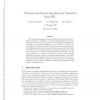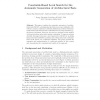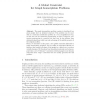CSL
2008
Springer
14 years 9 months ago
2008
Springer
Abstract. A positive temporal template (or a positive temporal constraint language) is a relational structure whose relations can be defined over countable dense linear order witho...
CP
2008
Springer
14 years 9 months ago
2008
Springer
Backbone variables have the same assignment in all solutions to a given constraint satisfaction problem; more generally, bias represents the proportion of solutions that assign a v...
CP
2008
Springer
14 years 9 months ago
2008
Springer
The Constraint Satisfaction Problem (CSP) framework allows users to define problems in a declarative way, quite independently from the solving process. However, when the problem i...
FLAIRS
2007
14 years 9 months ago
2007
We deal with the search process of the GraphPlan algorithm in this paper. We concentrate on a problem of finding supports for a sub-goal which arises during the search. We model t...
CP
2009
Springer
14 years 10 months ago
2009
Springer
Abstract. This paper considers the automatic generation of architectural tests (ATGP), a fundamental problem in processor validation. ATGPs are complex conditional constraint satis...
SPDP
1991
IEEE
14 years 10 months ago
1991
IEEE
This paper develops two new algorithms for solving a finite constraint satisfaction problem (FCSP) in parallel. In particular, we give a parallel algorithm for the EREW PRAM model...
CP
2006
Springer
14 years 11 months ago
2006
Springer
Abstract. Thanks to its extended expressiveness, the quantified constraint satisfaction problem (QCSP) can be used to model problems that are difficult to express in the standard C...
CP
2006
Springer
14 years 11 months ago
2006
Springer
Abstract. In the last decades, the Satisfiability and Constraint Satisfaction Problem frameworks were extended to integrate aspects such as uncertainties, partial observabilities, ...
CPAIOR
2004
Springer
14 years 11 months ago
2004
Springer
The graph isomorphism problem consists in deciding if two given graphs have an identical structure. This problem can be modeled as a constraint satisfaction problem in a very strai...
CISSE
2009
Springer
14 years 11 months ago
2009
Springer
: We show that estimating the complexity (mean and distribution) of the instances of a fixed size Constraint Satisfaction Problem (CSP) can be very hard. We deal with the main two ...



